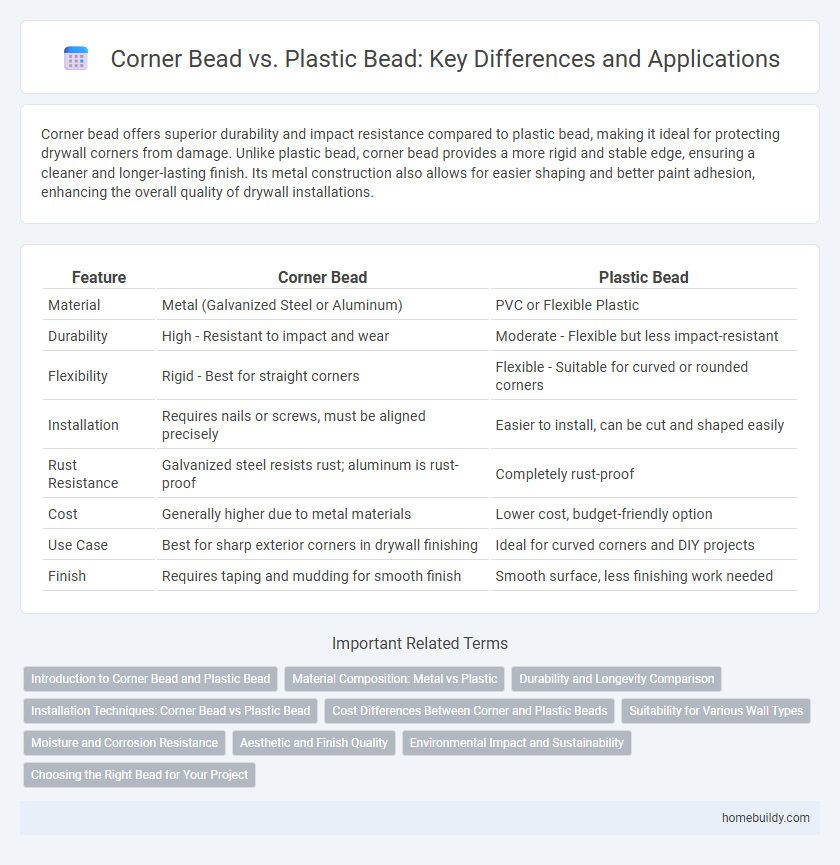Corner bead offers superior durability and impact resistance compared to plastic bead, making it ideal for protecting drywall corners from damage. Unlike plastic bead, corner bead provides a more rigid and stable edge, ensuring a cleaner and longer-lasting finish. Its metal construction also allows for easier shaping and better paint adhesion, enhancing the overall quality of drywall installations.
Table of Comparison
| Feature | Corner Bead | Plastic Bead |
|---|---|---|
| Material | Metal (Galvanized Steel or Aluminum) | PVC or Flexible Plastic |
| Durability | High - Resistant to impact and wear | Moderate - Flexible but less impact-resistant |
| Flexibility | Rigid - Best for straight corners | Flexible - Suitable for curved or rounded corners |
| Installation | Requires nails or screws, must be aligned precisely | Easier to install, can be cut and shaped easily |
| Rust Resistance | Galvanized steel resists rust; aluminum is rust-proof | Completely rust-proof |
| Cost | Generally higher due to metal materials | Lower cost, budget-friendly option |
| Use Case | Best for sharp exterior corners in drywall finishing | Ideal for curved corners and DIY projects |
| Finish | Requires taping and mudding for smooth finish | Smooth surface, less finishing work needed |
Introduction to Corner Bead and Plastic Bead
Corner bead is a metal or vinyl strip used to reinforce and protect drywall corners, ensuring straight, durable edges and preventing cracks. Plastic bead, often made from PVC, offers flexibility and resistance to moisture, making it ideal for curved surfaces or areas exposed to humidity. Both materials provide essential structural support, but the choice depends on installation requirements and environmental conditions.
Material Composition: Metal vs Plastic
Corner beads are commonly made from metal or plastic, with metal variants typically composed of galvanized steel or aluminum, offering superior durability and resistance to impact. Plastic beads, often constructed from PVC or vinyl, provide lightweight flexibility and resistance to moisture, making them ideal for humid environments. The choice between metal and plastic corner beads depends on the specific application requirements, balancing strength, corrosion resistance, and installation ease.
Durability and Longevity Comparison
Corner bead, typically made from galvanized steel or aluminum, offers superior durability and longevity compared to plastic bead, which is prone to cracking and warping over time. Metal corner beads resist impacts, moisture, and temperature fluctuations, ensuring a longer-lasting, resilient finish for drywall corners. Plastic beads may be easier to install but often require more frequent replacement due to their lower resistance to wear and environmental factors.
Installation Techniques: Corner Bead vs Plastic Bead
Corner bead installation typically requires nailing or screwing metal strips to drywall corners, providing a durable and precise edge. Plastic bead installation often involves adhesive backing or staples, allowing for easier manipulation around curves and flexibility but may lack the rigidity of metal corner bead. Proper alignment and securing techniques are essential for both to ensure smooth, crack-resistant drywall corners.
Cost Differences Between Corner and Plastic Beads
Corner bead typically costs more than plastic bead due to its metal composition, which offers enhanced durability and strength for drywall corners. Plastic beads are generally cheaper, making them a cost-effective option for budget-conscious projects but may lack the robustness of metal corner beads. Choosing between the two depends on balancing upfront material costs with long-term durability and maintenance expenses.
Suitability for Various Wall Types
Corner bead made of metal offers superior durability and is ideal for high-traffic areas or walls prone to impact, such as drywall and plaster surfaces. Plastic beads are lightweight, resistant to rust and corrosion, making them suitable for moisture-prone environments like bathrooms and kitchens. Selecting between corner bead and plastic bead depends on the wall material, exposure to wear, and environmental conditions for optimal reinforcement and finish.
Moisture and Corrosion Resistance
Corner bead made of galvanized steel offers superior corrosion resistance compared to plastic bead, making it ideal for areas exposed to high moisture. Plastic bead, while resistant to water, can lack the structural durability that metal corner bead provides in humid or wet environments. Moisture and corrosion resistance are critical for maintaining the integrity and longevity of drywall corners, especially in bathrooms and basements.
Aesthetic and Finish Quality
Corner bead offers superior aesthetic appeal compared to plastic bead, providing cleaner, sharper edges that enhance the overall finish quality of drywall installations. Metal corner bead resists dents and maintains its shape better over time, resulting in consistently smooth and professional-looking corners. Plastic bead may warp or crack under stress, compromising the visual integrity and durability of finished surfaces.
Environmental Impact and Sustainability
Corner bead made from metal, typically galvanized steel, offers superior durability and recyclability compared to plastic bead, which is often composed of non-biodegradable PVC or vinyl materials. Metal corner bead reduces landfill waste due to its high recyclability rate, while plastic bead contributes to persistent environmental pollution and challenges in recycling processes. Choosing metal corner bead supports sustainable construction practices by minimizing environmental impact through material longevity and end-of-life recyclability.
Choosing the Right Bead for Your Project
Corner beads, typically made from metal like galvanized steel or aluminum, offer superior durability and impact resistance compared to plastic beads, making them ideal for high-traffic areas or commercial projects. Plastic beads, often made from PVC, are lightweight, rust-proof, and easier to cut, suitable for residential walls where moisture resistance is essential. Selecting the right bead depends on the specific requirements of your project, such as durability, environmental conditions, and ease of installation.
corner bead vs plastic bead Infographic

 homebuildy.com
homebuildy.com